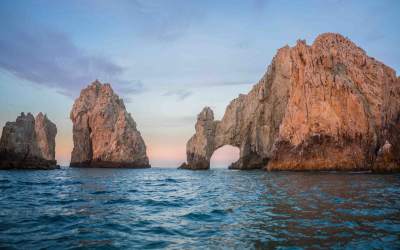Best Snorkel and Dive Spots in Los Cabos
World-famous explorer and conservationist Jacques Cousteau once called the waters around Los Cabos the “World’s Aquarium”, recognising the huge diversity and population of the marine life that called the Sea of Cortez home. And he wasn’t exaggerating; the 7,000 hectares of marine area in the Cabo Pulmo National Park alone is home to around 500 different species. In addition, after intense over-fishing was halted in the 1990s, the biomass of life on the reef has increased 400%. While those numbers are impressive, nothing is quite as striking as seeing this spectacle of nature face-to-fish – so here are the tips for the best scuba and snorkelling spots in Los Cabos.
[caption id="attachment_1406" align="alignnone" ] A whale shark in shallow waters.[/caption]
A whale shark in shallow waters.[/caption]
La Paz
While La Paz might be the capital of Baja California Sur, the state in which Los Cabos is located, the city is not all hustle and bustle like its counterparts in Mexico’s other states. Instead, La Paz leans into its tropical paradise status, with long stretches of beach, perfect water and just the right kind of climate for a laid-back holiday. From October, majestic goliaths call these waters home, as huge Whale Sharks – the world’s largest fish – glide around the reefs.
Snorkelling next to these gentle giants is an incredible and unique opportunity. Despite their size (and the “shark” nametag), the creatures are completely harmless to humans, instead feeding on plankton that they filter out of the water with their enormous mouths. That means you’re able to get right up next to the sharks as they continue their feeding, but keep your eyes peeled for the range of other rays, sharks and fish that are swimming around the area. Cabo Adventures operate a tour that takes you out to see the Whale Shark feeds at certain times of year, picking up adventurous swimmers from their hotels all around Cabo.

El Arco
Possibly the most famous landmark in all of Los Cabos, El Arco (“The Arch”) is often used to represent the destination in one memorable image. However, beyond just the picturesque setting, the Arch at Land’s end is teeming with marine life. Sea Lions congregate around the formation, hopping onto the beaches when they want to catch some sun, and frolicking in the shallow waters for food and play. Getting to the arch is straightforward; a short boat ride from the harbour at Cabo San Lucas delivers you right into the action, or you can make your own way via paddle board or kayak.
Once you’re in the pristine marine meadow, strap on a snorkelling mask to take in the incredible submarine views. Eye the sea lions or the fish, count the flashes of tropical colour, or perhaps discover a new species in the mix. For scuba divers, once you’re done with the Arch (that might take longer than you think once you see the beauty of it), head around to Lover’s Beach and Divorce Beach, or catch a glimpse of the waterfall effect on the ocean floor at Sand Falls, first discovered by Cousteau over forty years ago.

Cabo Pulmo
Divers might enjoy the life in the shallows of The Arch, however, the peak (or depth, as it may be) of scuba action in Baja is at the World’s Aquarium, Cabo Pulmo. With dives ranging all the way down to 100ft, there is a spread of tours available for divers of all experience and qualification. Individual dives can head to one of the many reefs, the two wrecks and out to El Islote island.
Under the waves, it’s likely you’ll encounter whole schools of sardines, snapper, and surgeon fish, as well as sea lions, bull and tiger sharks, manta rays, eels, and occasionally whale sharks on their migratory journey. For most of the year, wetsuits aren’t too necessary in the shallows, but from November to March, when you’re most likely to see the larger beasts, it’s best to jump into the 7mm suits to keep warm in the waters. Cabo Pulmo Beach Resort offers guests the chance to take classes and dives geared towards everyone from beginners to the Aquamen amongst you, as well as snorkelling for those who don’t want to strap into the bigger gear.


